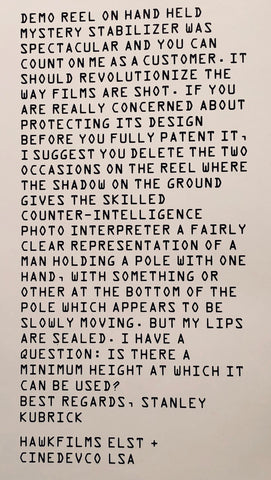May 23, 2022
May 23, 1980, Stanley Kubrick's hotel horror classic, The Shining hit theaters. Destined to become a staple of modern culture, it was not an instant hit. It seems the critics of the day didn't quite know what to make of this twist on the accepted horror genre. Amid the mixed reviews, though, were scattered references to the film's stunning visuals. At the time, the camera’s novel fluid mobility—thanks to the recently invented Steadicam—was a new technique, soon to be embraced by the biggest names in filmmaking.
A telex from Kubrick
The Shining wasn’t the first film to use Steadicam. Inventor Garrett Brown had debuted the system in 1976 on a handful of films including two Academy Award winners, Bound for Glory, for Cinematography, and Rocky, for Best Picture, which featured Stallone’s famous run up the Philadelphia museum stairs—inspired by a demo film Brown had made in that same location. Kubrick’s interest in the system had been piqued in 1974 by that demo, leading to a telex to Brown in which the director suggested prophetically, that the system might “revolutionize the way films are shot.”
 |
The response from such an august figure was, Brown recalls, “Electrifying. At the end of the note Stanley asked if there was a minimum height at which it could be used —I think because he already had the galleys for The Shining, and was planning the shots.” The two would eventually meet at the Film 77 Exposition in London at a time when sets had barely begun construction. Soon after, Brown had his first Model II Steadicam which included some design changes propelled by Kubrick's queries. The new inverted configuration made it possible to position the lens closer to the ground. “It separated the monitor and allowed me to do low mode. Plus I had a bracket made to fly the Arri BL2 camera.” |
Telex that Stanley Kubrick sent to Garrett Brown
Steadicam Model II
The Shining wasn’t the first film to use Steadicam. Inventor Garrett Brown had debuted the system in 1976 on a handful of films including two Academy Award winners, Bound for Glory, for Cinematography, and Rocky, for Best Picture, which featured Stallone’s famous run up the Philadelphia museum stairs—inspired by a demo film Brown had made in that same location. Kubrick’s interest in the system had been piqued in 1974 by that demo, leading to a telex to Brown in which the director suggested prophetically, that the system might “revolutionize the way films are shot.”
The response from such an august figure was, Brown recalls, “Electrifying. At the end of the note Stanley asked if there was a minimum height at which it could be used —I think because he already had the galleys for The Shining, and was planning the shots.” The two would eventually meet at the Film 77 Exposition in London at a time when sets had barely begun construction. Soon after, Brown had his first Model II Steadicam which included some design changes propelled by Kubrick's queries. The new inverted configuration made it possible to position the lens closer to the ground. “It separated the monitor and allowed me to do low mode. Plus I had a bracket made to fly the Arri BL2 camera.”

Garrett Brown shooting 'The Maze' scene in The Shining
Two-Handed Technique
While remote focus and viewing systems would hugely improve over the coming decades, Brown fondly recalls the innovations in operating technique that remain common practice to this day. “The main invention was the two-handed technique, which was firmed up on the thousands of lengthy takes the director called for on The Shining. In order to hold those frames high or low you needed to have one hand on the arm, and place it in space, and the other hand for pan and tilt. As soon as I learned to do it with two hands, which fortunately happened at the time we started shooting, it all became marvelously clear – and that’s what I knew I had to teach people.”
 Garrett Brown training someone at a Steadicam Workshop
Garrett Brown training someone at a Steadicam Workshop
Steadicam Workshops
With these new techniques in mind, and with The Shining prominent among a clutch of early successes which would rocket Steadicam into the mainstream, Brown realized that his impromptu approach to training people on the system would not keep up with demand. To answer growing demand, the first formal workshop for new operators took place in 1980, just after the film’s release. Steadicam Workshops have been conducted on six continents for more than four decades as new technologies continue to improve the equipment.Now, forty-two years later, that dedication to passing the baton is as well-remembered as the work itself. Operator Chris Haarhoff, whose Steadicam history stretches back to the '80s with highlights including Birdman, the Westworld series and Jurassic World, describes Brown’s contribution in glowing terms. “His energy has permeated the spine of Steadicam operators around the world. Rocky, Bound for Glory, The Shining… he set the bar so high right out of the box! Those of us who have chosen to follow in his footsteps know that we are so very fortunate and lucky to call Garrett our mentor and friend. Watching The Shining so many years later, he’s still schooling all of us.”
The Shining is today regarded by audiences and film aficionados alike as one of the greatest horror films ever made. In 2018, it was chosen for preservation in the United States National Film Registry by the Library of Congress as being "culturally, historically, or aesthetically significant," and the original Steadicam prototypes will soon be prominently on view in the Academy Museum of Motion Pictures in Los Angeles.
